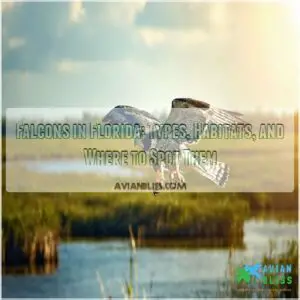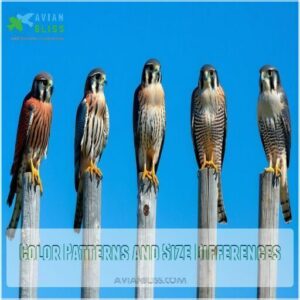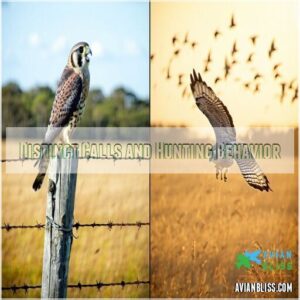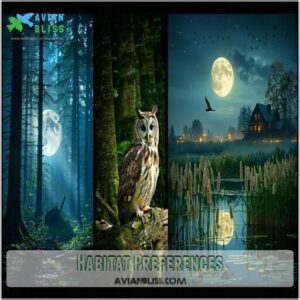This site is supported by our readers. We may earn a commission, at no cost to you, if you purchase through links.
 You’ll find four main falcons in Florida: the American Kestrel (the smallest), Merlin, Peregrine Falcon (the speed demon), and Crested Caracara (the odd one out).
You’ll find four main falcons in Florida: the American Kestrel (the smallest), Merlin, Peregrine Falcon (the speed demon), and Crested Caracara (the odd one out).
These birds of prey call various Florida habitats home, from open grasslands to coastal areas.
American Kestrels hover like helicopters before diving for prey, while Peregrines can reach 240 mph in a hunting stoop.
The best spotting locations include Everglades National Park and Merritt Island Wildlife Refuge.
Winter brings migratory species, making it prime falcon-watching season.
The secret to distinguishing these raptors lies in their distinctive silhouettes and hunting behaviors.
Table Of Contents
- Key Takeaways
- Types of Falcons in Florida
- Falcon Identification Tips
- Falcon Habitats in Florida
- Seasonal Presence and Migration Patterns
- Falcon Characteristics and Behaviors
- Conservation Status and Threats
- Where to Spot Falcons in Florida
- Frequently Asked Questions (FAQs)
- What is the most common falcon in Florida?
- Did I see a hawk or a falcon?
- How aggressive are peregrine falcons?
- Are there Falcons in Florida?
- What do Falcon birds eat in Florida?
- Where can you see Falcons in Florida?
- Where do peregrine falcons live in Florida?
- What is the tiniest Falcon?
- What birds of prey can you spot in Florida?
- What is the difference between a falcon and a hawk in Florida?
- Conclusion
Key Takeaways
- You’ll find four main falcons in Florida: the American Kestrel, Merlin, Peregrine Falcon, and Crested Caracara, each adapted to different habitats like grasslands, coasts, and urban areas.
- Peregrine Falcons are speed demons, hitting up to 240 mph in a stoop, while American Kestrels excel at hovering mid-air before diving for prey.
- Winter is the best time to spot migratory falcons in Florida, with birding hotspots like Everglades National Park and Merritt Island Wildlife Refuge offering prime viewing.
- Falcons face threats like habitat loss and urbanization, but conservation efforts, including habitat restoration and nest box programs, help protect their populations.
Types of Falcons in Florida
Florida is home to a fascinating variety of falcons, each with unique traits and behaviors.
From the speedy Peregrine Falcon to the colorful American Kestrel, you’ll find these birds thriving in diverse habitats across the state.
American Kestrel Characteristics
The American Kestrel, the smallest falcon species in Florida, stands out with its striking colors and agile flight.
Male kestrels flaunt blue-gray wings and reddish backs, while females wear subtle earth tones.
Known for expert hovering, these falcons patrol open fields for prey with sharp precision.
Here’s what makes the American Kestrel unique:
- Kestrel Size: Compact and slender for swift aerial maneuvers.
- Kestrel Diet: Hunts insects, rodents, birds, and reptiles.
- Kestrel Colors: Males are vibrant; females are more muted.
- Kestrel Vocalizations: A cheerful “klee-klee-klee” often heard above Florida’s countryside.
A favorite for falcon identification in Florida!
Merlin Falcon Habitat
Merlin Falcons thrive in Florida’s diverse landscapes, from grasslands to wetland edges and coastal environments.
These nimble predators patrol open areas and shrubby fields, scanning for prey abundance like small birds or insects.
You’ll also find them adapting to cities, using structures or tree cavities as roosting and nesting locations.
During winter, they frequent habitats near water, benefiting from rich food supplies.
However, habitat threats, including urban sprawl, disrupt their nesting sites.
Protecting Florida bird habitats is key to their survival.
For birdwatchers, spotting these falcons is easiest in areas with mixed vegetation, where their stealth and speed shine.
Peregrine Falcon Speed
The Peregrine Falcon stands out among Florida falcons as a true icon of speed and precision.
Known as the fastest creature on Earth, it reaches dive speeds of up to 247 mph thanks to its extraordinary biomechanics and hunting aerodynamics. Its streamlined body, powerful wings, and stiff tail create unmatched control, making prey capture a seamless act of dominance.
Here’s why the Peregrine Falcon is nature’s high-speed predator:
- Dive Speed: Clocking in faster than race cars during vertical dives.
- Precision Hunting: Perfect aerial strikes, targeting over 450 bird species.
- Speed Evolution: Adapted over time for efficient prey capture mid-air.
- Aerodynamic Mastery: Tapered wings and streamlined feathers reduce drag.
Spotting one soaring through Florida’s skies feels like watching a stealth jet live—raw power and grace in motion.
Crested Caracara Description
The Crested Caracara stands out among Florida raptors with its vulture-like behavior and striking appearance.
This unique falcon species combines bold plumage details with practical adaptations for scavenging. Its orange facial skin, cream-colored neck, and black body are unmistakable.
- Diet: Primarily carrion, but it also hunts reptiles and small mammals.
- Leg Color: Bright yellow, perfect for ground foraging.
- Behavior: Unlike most Florida falcons, it’s often seen walking while searching for food.
Falcon Identification Tips
To identify falcons in Florida, focus on their size, color patterns, and unique features like leg feathering or beak shape.
Pay attention to their behaviors, such as hunting styles and habitat preferences, to distinguish between species, considering their unique features to ensure accurate identification.
Color Patterns and Size Differences
To identify falcon species in Florida, pay attention to plumage variation and size. The American Kestrel, the smallest falcon in Florida, flaunts a rusty-orange back and slate-blue wings, while the Peregrine Falcon showcases a striking blue-gray back with a white chest and dark barring.
Size differences help too—Kestrels are petite at 9–12 inches, whereas the Crested Caracara stands tall at 20–25 inches.
Sexual dimorphism is evident in Kestrels, with males showing brighter colors than females. Juveniles across species often have more streaked and muted plumage, making their identification trickier.
A falcon identification guide can further assist in distinguishing subtle differences.
Regional differences also play a role; for instance, some Peregrines in Florida may show slight size overlap with Merlins, complicating comparisons. Observing wing shapes, tail length, and markings will sharpen your falcon identification skills across Florida’s diverse habitats.
Distinct Calls and Hunting Behavior
If you’re trying to master falcon identification in Florida, listening for their unique calls is key. Each falcon species has distinct vocalizations serving purposes like communication, territorial defense, or alerting mates. Their calls often reveal their presence before you even spot them.
- American Kestrel: High-pitched "klee-klee-klee," echoing across open areas.
- Peregrine Falcon: Loud, sharp "kek-kek-kek," especially during aggressive displays.
- Merlin: Rapid, shorter "kek-kek-kek" bursts, often faster than peregrines.
- Crested Caracara: Unusual rattling trills, far from typical falcon sounds.
Hunting styles also highlight their behavior. Peregrines dive at breathtaking speeds, while kestrels hover mid-air before striking. Merlins rely on swift, aerial chases to catch songbirds. Caracaras, breaking the mold, often scavenge or hunt on foot.
To further refine your auditory identification skills, consider exploring resources that offer authentic Florida bird sounds. By recognizing these call variations and hunting techniques, you’ll sharpen your falcon identification skills while gaining deeper insight into their prey specialization and behavior.
Habitat Preferences
Understanding where falcons thrive can make spotting them easier and more rewarding. Each falcon species in Florida seeks habitats that meet their needs for nesting materials, prey availability, and water sources.
The primary habitats and nesting preferences of falcon species in Florida are as follows:
| Species | Primary Habitat | Nesting Preference |
|---|---|---|
| American Kestrel | Grasslands, fields | Tree cavities, nest boxes |
| Peregrine Falcon | Coastal, urban areas | Building ledges, cliffs |
| Crested Caracara | Wetlands, open areas | Palms, low trees |
Merlins often patrol forest edges, while kestrels hover over open spaces. Peregrines frequent Florida’s coasts, hunting shorebirds. Roosting sites vary, but accessible habitats guarantee survival.
For Florida birdwatching falcons, explore wetlands, grasslands, or urban rooftops—matching the habitat to the species boosts your chances of success! Observing vegetation types and densities can further refine your search.
Falcon Habitats in Florida
You’ll find falcons across Florida in habitats ranging from open grasslands to bustling urban areas.
They adapt well to human-made structures, often nesting on tall buildings or bridges where prey is abundant.
Open Areas and Grasslands
Florida’s grasslands are a falcon’s buffet and playground, offering vast spaces for hunting and nesting.
These open areas are hotspots for falcon species Florida is known for, like the American Kestrel and Peregrine Falcon.
To spot them, check:
- Fence posts and utility poles where kestrels perch, scanning for Grassland Prey.
- Prairie edges with abundant small mammals and birds.
- Cattle ranches where short grasses reveal rodents, boosting Kestrel Density.
- Conservation areas managed for Open Area Conservation, ensuring thriving falcon habitats.
Consider using a specialized viewing equipment for enhanced observation.
These habitats showcase nature’s balance, where falcons master Falcon Foraging.
Coastal Regions and Urban Areas
Falcons showcase their adaptability in Florida’s coastal prey zones and bustling cities.
Along the shores, species like the American Kestrel and Merlin hunt seabirds and small mammals, thriving under the saltwater influence.
In urban areas, urban falcons Florida, such as the Peregrine Falcon, transform skyscrapers into perfect urban nesting sites, preying on pigeons with precision.
This habitat adaptation highlights their resilience.
For Florida birdwatching falcons, explore Gulf Coast beaches or downtown skylines where these raptors balance human interaction with their natural instincts.
Human-made Habitats and Nesting Sites
Urban falcons in Florida have shown incredible adaptability, often turning human-made structures into perfect nesting spots. Skyscrapers, bridges, and power towers mimic the natural cliffs they favor, offering safety from predators and plenty of hunting opportunities. Peregrine Falcons, in particular, thrive in these environments.
These birds often utilize platform nests for stability.
You can help support falcon nesting Florida efforts with simple actions:
- Install artificial nests like rooftop platforms or nest boxes designed for falcons.
- Join nest box programs or conservation groups focused on protecting urban falcons Florida.
- Report bridge nesting or other sites to wildlife agencies to aid monitoring.
These efforts not just protect falcons but also highlight how urban adaptation benefits these remarkable birds.
Seasonal Presence and Migration Patterns
You’ll notice that falcons in Florida display fascinating seasonal patterns, with some species migrating while others stay put year-round.
Understanding these movements helps you predict when and where to spot each type, from the wintering Merlin to the ever-present Peregrine Falcon.
American Kestrel Migration Patterns
As the smallest falcon in North America, the American Kestrel’s migration is a fascinating spectacle.
These agile hunters follow Kestrel Flyways from northern Breeding Grounds to Wintering Locations like Florida, guided by Migration Triggers such as shorter days and dwindling prey. Females and juveniles typically lead the journey, leaving weeks before males.
In Florida, kestrels settle in open fields, farmlands, and urban edges, creating a vibrant part of the state’s bird migration scene. Their stopovers, rich in food, are essential for refueling during long flights.
Here’s a quick snapshot of their migration:
| Aspect | Timing | Behavior | Impact |
|---|---|---|---|
| Departure | Late summer/fall | Females leave first | Supports survival |
| Arrival in Florida | Early winter | Settle in diverse habitats | Thrives in ecosystems |
| Stopover Sites | Along flyways | Prey-rich areas | Fuels migration |
| Climate Impact | Variable routes | Adjusts to conditions | Affects patterns |
Merlin Wintering Habits
Merlin falcons embrace Florida’s mild winters, showcasing fascinating roosting behavior. Their habitat selection revolves around food and safety, ensuring higher survival rates.
You’ll spot them in diverse areas:
- Coastal marshes teeming with shorebirds, their favorite prey.
- Open woodlands, ideal for perching and strategic hunting.
- Urban parks, offering smaller birds and ample cover.
These solitary hunters adapt their dietary shifts to winter prey, making falcon sightings in Florida a thrilling experience. The American Kestrels’ wintering range extends into Florida as well.
Peregrine Falcon Year-Round Presence
Spotting a Peregrine Falcon in Florida is unforgettable. These masters of speed live here year-round, thriving across coastal areas, inland regions, and urban centers. Tall buildings mimic cliffs, making cities ideal nesting sites during the nesting season. With unmatched urban adaptations, they’ve embraced the modern world.
You’ll often see their streamlined silhouettes soaring high, wings beating powerfully. Watch closely—Florida wildlife falcons glide swiftly, diving at speeds nearing 200 mph to catch prey mid-air. Their stay varies due to population dynamics, with some peregrine falcon Florida populations remaining stable while others migrate for prey availability.
Here’s a quick look at Peregrine Falcons:
| Feature | Details | Relatable Fact |
|---|---|---|
| Speed | Up to 200 mph | Fastest animal on Earth |
| Nesting Season | Year-round Florida | Prefers cliffs, skyscrapers |
| Wingspan | 43-46 inches | As wide as a toddler’s height |
| Prey Availability | Birds, bats, insects | Adapts based on species |
| Conservation Challenges | Pesticides, habitat loss | Effort-intensive to protect! |
Crested Caracara Non-Migratory Behavior
Unlike Peregrine Falcons, the Crested Caracara stands out with its year-round presence in Florida, adapting perfectly to local conditions.
These striking falcons are often spotted walking confidently across open terrain, a rare sight among raptors.
In falcon habitat Florida, Crested Caracaras showcase unique behaviors:
- Local Adaptation: Thriving in grasslands and ranchlands.
- Territory Defense: Vocalizations and striking posturing to mark their ground.
- Year-Round Diet: A mix of scavenged carrion and hunted prey like reptiles or small mammals.
- Breeding Season Habits: Building bulky nests in cabbage palms or low trees, ensuring stability.
Falcon Characteristics and Behaviors
Falcons are remarkable for their speed, agility, and sharp hunting skills, making them efficient predators across Florida’s diverse habitats.
These birds exhibit unique behaviors, like mid-air prey capture and nesting in reused sites, showcasing their adaptability and ecological importance.
Speed and Agility
Florida’s falcons are aerial athletes, showcasing exceptional flight mechanics and breathtaking agility.
You’ll be amazed at how each species uses its unique skills to dominate the skies.
- Peregrine Falcons perform jaw-dropping hunting dives, hitting speeds over 200 mph!
- Merlins are masters of aerial acrobatics, twisting and turning mid-flight to outmaneuver prey.
- American Kestrels hover gracefully, their wings beating fast as they scan the ground below.
All falcons have sleek, aerodynamic bodies that allow swift evasion tactics, reducing air resistance.
Every wingbeat exemplifies years of agility training written by nature itself!
Hunting Techniques and Prey
Falcons in Florida showcase incredible aerial prowess with hunting styles adapted to their environment and prey.
The Peregrine Falcon’s unparalleled speed, diving at 200 mph, allows it to strike birds mid-flight with precision.
Merlins rely on ambush tactics and rapid directional changes to surprise smaller songbirds, showcasing agility in open areas.
Meanwhile, American Kestrels demonstrate diet diversity, hovering steadily before diving onto rodents, insects, or small birds.
The Crested Caracara breaks the mold, combining scavenging with ground-hunting for reptiles or small mammals, reflecting its unique prey specialization.
Each species uses capture methods perfectly suited to their diet and habitat, highlighting falcon hunting Florida as both a spectacle of skill and nature’s balance.
Social Behavior and Nesting Habits
Falcons inspire awe with their fascinating social and nesting behavior. During the breeding season, pair bonding takes center stage through mesmerizing aerial acrobatics and food-sharing rituals.
Their choice of nesting sites reflects remarkable adaptability—natural cliffs, tall trees, or urban skyscrapers. Fiercely monogamous, many falcons reuse successful nests annually and fiercely guard territories.
Both parents share chick-rearing duties, strengthening bonds and ensuring survival. Observing falcon behavior offers insights into their complex social hierarchy and cooperative hunting habits.
- Mating Displays: Spiraling dives and synchronized flights.
- Territorial Defense: Loud calls and daring mid-air chases.
- Nesting Preferences: Rocky ledges, abandoned hawk nests, cityscape perches.
Conservation Status and Threats
Falcons in Florida face numerous threats, including habitat loss, human interference, and pesticide exposure. Understanding these challenges is essential to supporting conservation efforts and protecting their populations.
Peregrine Falcon Recovery Efforts
The dramatic comeback of Peregrine Falcons took off after the 1972 ban on DDT, which had devastated their populations across Florida and beyond.
Once teetering on extinction’s edge, these aerial hunters have soared back through coordinated recovery efforts.
The Peregrine Fund, established in 1970, spearheaded innovative nesting programs that reintroduced falcons to urban environments where they’ve thrived on skyscrapers and bridges.
Regular population monitoring confirms their remarkable resurgence, leading to their removal from the endangered species list in 1999.
Legal protections and falcon rehabilitation initiatives continue throughout Florida, ensuring these magnificent birds maintain healthy numbers.
While future challenges remain, falcon conservation in Florida stands as a shining example of what’s possible when science-based management meets determined environmental stewardship.
Habitat Loss and Fragmentation
While Peregrine recovery shows promise, habitat loss continues to threaten Florida’s falcon populations.
Urban development and agricultural expansion fragment natural landscapes where these birds once thrived.
Wetland destruction particularly impacts species like the American Kestrel that depend on these ecosystems for hunting.
- Fragmented habitats reduce prey availability, forcing falcons to travel farther between hunting grounds
- Natural connectivity corridors disappear as developments create impassable barriers
- Nesting sites vanish when tall trees and structures are removed for construction
You’ll notice falcon populations concentrating in remaining wild spaces as their territories shrink.
Florida ecosystems depend on these predators for balance, making habitat preservation essential for wildlife conservation.
Falcon conservation efforts in Florida now focus on protecting these diminishing habitats before they’re lost forever.
Human Impact on Falcon Populations
The widespread use of DDT nearly wiped out Peregrine falcon populations in Florida before pesticide bans reversed their decline.
You’ll find that urbanization continues to eliminate essential nesting sites, particularly affecting American Kestrels that depend on specific habitats.
Habitat destruction from development projects has forced falcons to adapt, with some species now using man-made structures like bridges and buildings for nesting.
Climate change poses a growing threat to coastal habitats through rising sea levels, while wind energy development creates deadly obstacles along migration routes.
When you visit beaches or recreational areas, your presence might disrupt nesting if you’re not careful.
Even well-intentioned photographers can stress birds during breeding season.
Fortunately, falcons are considered birds of prey, expertly adapted for hunting.
Fortunately, falcon conservation efforts in Florida have shown promise.
Protected areas, artificial nest platforms, and reduced pesticide use have helped reverse population declines—proving we can share Florida’s skies when we take responsibility for our impact.
Where to Spot Falcons in Florida
You’ll find Florida’s remarkable falcon species at key birding hotspots including Everglades National Park, Merritt Island Wildlife Refuge, and the shorelines of Lake Okeechobee.
These locations offer prime viewing opportunities where you can spot Peregrine Falcons diving at incredible speeds, American Kestrels hovering above grasslands, and if you’re lucky, the distinctive Crested Caracara patrolling open fields.
Florida Birding Hotspots
While protecting bird populations, conservationists have established premier Florida birdwatching locations where falcon spotting success rates remain high. The Great Florida Birding Trail connects these stellar viewing areas across the state.
For ideal falcon photography spots, visit these inland sanctuaries and coastal birding destinations:
- Ding Darling National Wildlife Refuge – Southwest Florida sanctuary with trails offering prime Peregrine Falcon viewing
- Merritt Island National Wildlife Refuge – Central Florida’s Black Point Wildlife Drive provides car-based falcon observation
- St. Marks National Wildlife Refuge – North Florida location with excellent raptor seasonal viewing
Morning hours (dawn to 11 a.m.) yield the most activity, particularly during winter months when northern falcon species migrate to Florida. Bring quality binoculars, maintain distance, and consider joining expert-led tours for enhanced falcon spotting opportunities.
Everglades National Park
Moving beyond typical birding hotspots, the Everglades National Park stands as Florida’s falcon paradise with over 300 documented bird species.
The Everglades ecosystem provides ideal falcon prey with its diverse habitats. Conservation efforts protect these hunters from park threats including habitat loss.
| Location | Falcon Species | Best Viewing Tips |
|---|---|---|
| Snake Bight Trail | Peregrine Falcon | Dawn viewing, bring telephoto lens |
| Mahogany Hammock | Crested Caracara | Early morning spring visits |
| Open sawgrass prairies | American Kestrel | Watch for hovering behavior |
| Flamingo area | Merlin | Winter months ideal |
| Aerojet Road vicinity | Multiple falcon species | Join ranger-led birding tours |
Merritt Island National Wildlife Refuge
A bird-watcher’s paradise, Merritt Island National Wildlife Refuge spans 140,000 acres of prime falcon habitat just east of Titusville.
This coastal sanctuary offers exceptional viewing opportunities for Florida’s diverse birds of prey.
For ideal falcon sightings Florida:
- Time your visit during winter months when Peregrine Falcons and Merlins migrate to the refuge
- Drive the Black Point Wildlife Drive where American Kestrels frequently hunt over open areas
- Scan marshes and shorelines where seasonal abundance of prey attracts these aerial hunters
Bring binoculars to appreciate the refuge birdlife in their natural habitat management areas.
The refuge also attracts a variety of shorebirds and seabirds adding to the birding experience.
Lake Okeechobee
At the heart of Florida’s birding paradise, Lake Okeechobee offers prime falcon sightings along its Scenic Trail.
You’ll spot American Kestrels and Peregrine Falcons hunting over this massive freshwater ecosystem, where water management impacts create diverse habitats for birds of prey.
| Falcon Species | Viewing Location |
|---|---|
| American Kestrel | Lake Okeechobee Ridge Trail |
| Peregrine Falcon | Herbert Hoover Dike |
| Crested Caracara | Fisheating Creek area |
| Merlin | Shoreline grasslands |
| Swallow-tailed Kite | Late July/early August |
For ideal falcon identification, visit the lake’s western side where fishing spots double as observation points.
Restoration initiatives have improved lake habitat quality, supporting a rich Okeechobee bird prey population.
Don’t miss the inland flooded fields at Belle Glade, where you might see over 100 falcons in a single day during migration seasons, and enjoy the diverse habitats for birds of prey, with water management impacts creating a unique ecosystem.
Frequently Asked Questions (FAQs)
What is the most common falcon in Florida?
While the swift Peregrine soars along coastlines, you’ll find the American Kestrel most frequently throughout the state.
They’re widespread and numerous across Florida’s woodland ecosystems, making them the most common falcon you’ll encounter.
Did I see a hawk or a falcon?
Without seeing the bird, it’s challenging to determine.
Falcons typically have pointed wings and slender bodies, while hawks are bulkier with rounded wings.
Description or photo would help identify your sighting accurately.
How aggressive are peregrine falcons?
You’ll find peregrine falcons are highly aggressive when defending their territory and nests.
They’ll fiercely attack intruders much larger than themselves, even locking talons with rivals to the death during breeding season.
Are there Falcons in Florida?
Yes, Florida is home to four falcon species.
You’ll find the Peregrine Falcon, American Kestrel, Merlin, and occasionally the Crested Caracara throughout the state, each with unique hunting behaviors and physical characteristics.
What do Falcon birds eat in Florida?
Falcons favor a flavorful feast of birds, insects, and small mammals.
In Florida, they’ll hunt midair for prey like doves and sparrows, snag scuttling lizards, or scavenge carrion, depending on the species.
Where can you see Falcons in Florida?
You’ll spot falcons in Florida’s wildlife refuges, open fields, and coastal areas.
Check spots like Everglades National Park or St. Marks Wildlife Refuge during migration seasons for the best chance to see these majestic hunters.
Where do peregrine falcons live in Florida?
It’s like Florida rolls out a red carpet for peregrine falcons, especially during migration.
They favor coastal areas, wetlands, and even city skyscrapers, expertly adapting to diverse habitats while eyeing smaller birds for meals.
What is the tiniest Falcon?
The tiniest falcon is the American Kestrel.
It’s about the size of a robin, measuring 9–12 inches long with a wingspan of 20–24 inches.
Despite its size, it’s a bold hunter.
What birds of prey can you spot in Florida?
Ever wonder which magnificent predators rule Florida’s skies?
You’ll find hawks, owls, eagles, and falcons like the Peregrine Falcon and American Kestrel, each showcasing unique hunting skills that’ll leave you awestruck in nature’s theater.
What is the difference between a falcon and a hawk in Florida?
Falcons are smaller, faster predators with pointed wings and slender bodies, excelling in aerial hunts.
Hawks are bulkier, with broader wings and tails, ideal for soaring.
Both thrive in Florida’s diverse habitats but differ in hunting styles.
Conclusion
Imagine falcons as Florida’s aerial Formula 1 racers, each breaking records in their habitats.
From the speedy Peregrine Falcon to the quirky Crested Caracara, these raptors showcase diversity and adaptability.
Spot them in hotspots like Everglades National Park, especially in winter when migratory species abound.
Learn their silhouettes, behaviors, and calls for identification.
Falcons in Florida thrive across grasslands, coasts, and urban areas, but conservation is key to their future.
Explore, observe, and protect these majestic birds.
- https://www.mass.gov/info-details/learn-about-peregrine-falcons
- https://myfwc.com/recreation/lead/fisheating-creek/
- http://www.biokids.umich.edu/critters/Falco_sparverius/
- https://defenders.org/wildlife/peregrine-falcon
- https://vt.audubon.org/news/making-sense-peregrine-falcon%E2%80%99s-variable-migration-patterns















